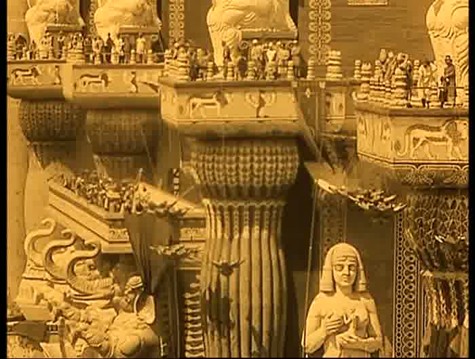Réalisation:
D.W. GriffithPhotographie:
G.W. BitzerMusique:
Carl DavisActeurs·trices:
Lillian Gish, Mae Marsh, Robert Harron, Sam De Grasse, Vera Lewis, Mary Alden, Elmo Lincoln, Olga Grey, Erich von Stroheim, Eugene Pallette (plus)Résumés(1)
Une jeune femme berce son bébé... Parallèlement, quatre destins se croisent à quatre époques. L'histoire de Belshazzar, le jeune roi de Babylone, et la destruction de son royaume. La chute de Babylone, fruit du complot des grands prêtres qui, redoutant l'introduction de nouvelles idées religieuses, trahirent la cité au profit de Cyrus, l'empereur des Perses. Cette histoire avec trois autres : la trahison de jésus se terminant par la crucifixion ; la trahison des Huguenots le soir de la Saint Barthélémy en 1572, lorsque 50.000 protestants furent massacrés à Paris ; et la lutte entre le capital et le travail dans les Etats-Unis modernes. (Diaphana Distribution)
(plus)Vidéo (1)
Critiques (2)
The cradle of intolerance, futility, and destruction is a classic Griffith epic that conjures art on every time plane. Yet if I were to choose one epoch in which I would like to spend more than three hours, it would undoubtedly be the Babylonian epoch of 539 BC.
()
Symbolism is certainly nothing new in film; after all, one of the pioneers of cinema, Georges Méliès, was the one who introduced this element. However, it was D. W. Griffith, who has perfected it. The conclusion of his brilliantly controversial epic The Birth of a Nation was proof of that, and the film Intolerance continues in that vein, with the woman rocking the cradle being a beautiful example of such film metaphor. No matter what happens, life goes on. Even when people are nasty to each other, they still have hope. Absolutely captivating is the storytelling format, alternating between four different stories, which was also why the film was too demanding for audiences of that time. The skipping between stories was confusing. Let's face it, audiences have a problem with that style of storytelling even today. However, D. W. Griffith once again showed his genius and ability to play with the young medium that film was. What is done with the camera, the editing, the narration, and also with the effects are elements that are still valid to this day. By the way, even the intertitles impress with their sophistication, just like the exposed breasts, which later certainly weren't commonplace. The fidelity in capturing historical periods in historical stories is truly breathtaking.
()
Photos (14)
Photo © Triangle Film Corporation



Annonces